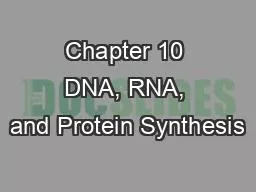

Section 1 Discovery of DNA All living things have DNA Your DNA holds the instructions for everything about you Fredrick Griffith Discovered transformation the transfer of genetic material from one cell to another cell or from one organism to another organism ID: 927526
Download Presentation The PPT/PDF document "Chapter 10 DNA, RNA, and Protein Synthes..." is the property of its rightful owner. Permission is granted to download and print the materials on this web site for personal, non-commercial use only, and to display it on your personal computer provided you do not modify the materials and that you retain all copyright notices contained in the materials. By downloading content from our website, you accept the terms of this agreement.
Slide1
Chapter 10DNA, RNA, and Protein Synthesis
Section 1 Discovery of DNA
Slide2All living things have DNA. Your DNA holds the instructions for everything about you.
Slide3Fredrick Griffith
Discovered
transformation
-
the transfer of genetic material from one cell to another cell or from one organism to another organism
He was looking for a vaccine against pneumonia.
Virulent
- disease-causing
Slide4Griffith’s Experiment
R (rough) strain-
no capsule
(harmless)
S(smooth) strain-
has a capsule
(causes pneumonia)
The capsule was destroyed with heat.
Slide5Oswald Avery
For years, people thought that genetic information was contained in cell protein.
Avery set out to find out if the transforming agent in Griffith’s experiment was DNA, RNA, or protein.
Slide6DNA, RNA, or Protein??
Avery and other scientists sequentially destroyed DNA, RNA, and protein.
In the RNA and protein- destroyed samples, the mice died
When DNA was destroyed, the mice lived.
His conclusion, DNA is the transforming agent in bacteria.
Slide7Hershey-Chase Experiment
Martha Chase and Alfred Hershey
Slide8Bacteriophage- a virus that infects bacteria
Slide9Hershey-Chase Experiment
Set out to answer the question of whether
DNA or protein
was the hereditary material viruses transfer when they enter a bacteria cell.
Slide10Their conclusion:
DNA is the hereditary molecule in viruses.
E. coli
Slide11Section 2: DNA Structure
By the early 1950s biologists accepted DNA as the hereditary material, but did not understand its structure or how the molecule could replicate, store and transmit information, or direct cell function.
Slide12James Watson and Francis Crick
Credited with the discovery of the structure of DNA. Perhaps even more significantly it explained how DNA could replicate.
Slide13Received the Noel Prize for their work.
Slide14Rosalind Franklin
She took x-ray photographs of DNA that helped
Slide15DNA Nucleotides consist of 3 parts:
1) A five-carbon sugar
(
deoxyribose
)
2) A phosphate
3) a nitrogen base (A) adenine
(T) thymine (G) guanine (C) cytosine
Slide16A DNA molecule
Hydrogen bonds
are located between the bases
Slide17Two groups of bases:
Purines
-
have 2 rings
Pyrimidines
- have one ring
Slide18Base-Pairing rules:
Cytosine pairs with Guanine
Adenine pairs up with Thymine
A plant’s DNA has nucleotides that are 20% thymine. What percentage of guanine would be present?
30%
Slide19Complementary Base Pairs
One
purine
pairs up with one
pyrimidine
Just one more thing…
Use the base-pairing rules to determine the base sequence that is complementary to the sequence
C-G-A-T-T-C-G
G-C-T-A-A-G-C